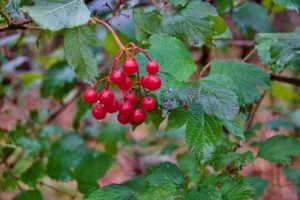highbush cranberry
Viburnum opulus var. americanum

Description:
The highbush cranberry is not a cranberry though its fruit looks and tastes like cranberries. It is part of the honeysuckle family, whereas the true (or low bush) cranberry is a member of the heather family.
Highbush cranberry grows in hardiness zones 2-7, is 8-15 feet tall and 8-10 feet wide. It tolerates frost and likes sun or semi-shade. This bush is successful in most soil types but does best in well-drained, moist soil that is rich and contains loam.
Use and Management:
This bush is a magnet for wildlife. It provides food for deer and birds. It can be used as a hedge by spacing plants 2-3 feet apart.
Additional Information:
highbush cranberry
References:
USDA Plants Database
Wisconsin Virtual Flora Database
Maine Cooperative Extension
Native Plant Network Propagation Protocol Database
USFS Fire Effects Information System Database
